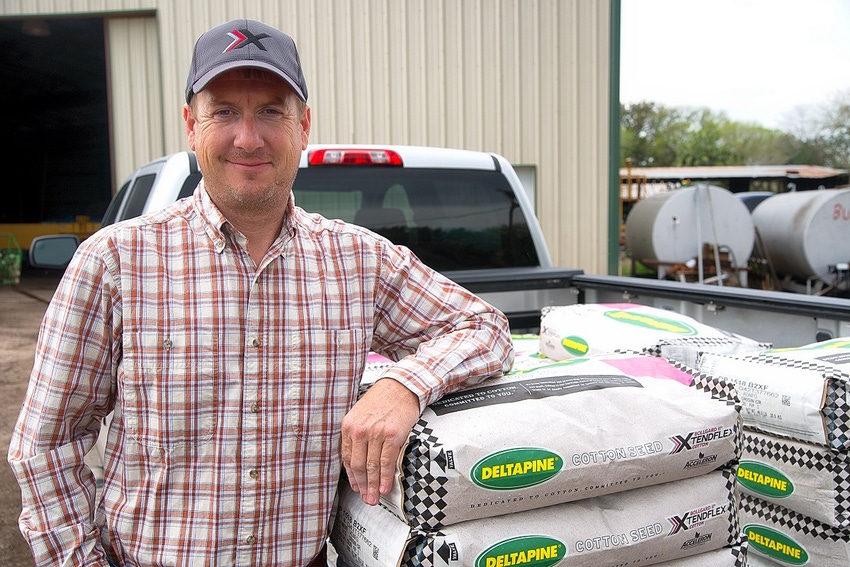
Levi Burns’ 2015 crop is turning out to be one for the record books. Burns set one historic mark by becoming the first farmer in the U.S. to plant one of the new commercially available Bollgard II XtendFlex cotton varieties on March 30.
Now he’s hoping the rest of his grain and cotton crops will be memorable ones – and not just because of the unseasonably heavy rains and cool temperatures he and other farmers in the Lower Rio Grande Valley have endured this spring.
“We planted the new Bollgard II XtendFlex variety – DP 1518 B2XF – in between the rains on March 30,” said Burns, who farms about 4,500 acres of corn, grain sorghum, wheat and cotton near Harlingen in the LRGV region of Texas. “We’re about two weeks late because of all the rain. Last year, I was finished planting cotton by March 10.
“But, as one of my guys said while we were combining wheat the other day, it sure beats the alternative.”
For the latest on southwest agriculture, please check out Southwest Farm Press Daily and receive the latest news right to your inbox.
Burns said the DP 1518 B2XF cotton “looks good,” when he was interviewed on April 30. “It was a little bit waterlogged at first because it rained for two nights after we planted it. It’s had a total of 4 inches of rain on it.”
The Bollgard II XtendFlex cotton trait, which is tolerant to glyphosate, glufosinate and dicamba herbicides, received approval from USDA earlier this year. For growers with access to the technology, glyphosate and glufosinate herbicides are approved for in-crop use, but over-the-top use of dicamba is still pending regulatory approval and cannot be used.
Every crop in the Lower Rio Grande Valley is late this year, he said. “Not only that, but we’ve been cutting wheat in the mud. We’re having to work a lot harder to keep the combine running and harvesting the wheat on a timely basis.”
Weather is a major factor in south Texas agriculture every year. The alternative Burns’ employee was referring to was the years in which crops in the Lower Rio Grande Valley have received almost no rainfall to speak of from emergence to harvest.
2015 has been the opposite with farmers struggling to get their crops planted early so they will emerge, grow and reach maturity before the south Texas heat – and dryer weather – begins to take its toll.
The DP 1518 B2XF cotton had three true leaves on most of the plants on April 30. With forecasts of sunshine, cool temperatures and low humidity for the following week, Burns believes the cotton should begin catching up from the effects of the wet weather.
“The low humidity has made it possible for us to keep running the combine until 1 or 2 in the morning, the last few days,” he said. “We started cutting wheat at 8 a.m. yesterday. That’s really unusual for us to be able to do that.”
Late planting
Besides the increasing temperatures and chances for the rain ending and drought returning in early summer, Burns and other farmers in the LRGV have another reason for concern due to the late planting of their crops.
“We normally start planting cotton on Feb. 25, but we couldn’t do that because of the rains this year,” he said. “Anytime you plant cotton in April, you’re asking for a hurricane to come in and destroy your crop. Aug. 2 is my birthday, and I like to be finished picking cotton by my birthday.”
In 2008, Burns defoliated some of his cotton on July 19th and 20th. He finished picking that cotton just before Hurricane Dolly hit the Texas Coast on July 23. “It wasn’t the best cotton I ever made, but I got it out before the hurricane.”
Despite the difficulties, Burns, who grew his first corn crop while he was in high school, says he wouldn’t trade farming for any other career. “God’s been good, and I’ve been blessed. I know where it all comes from.”
As a Deltapine New Product Evaluator or NPE grower, Burns grew a 1518-like variety that did not contain the XtendFlex gene in 2014. He’s growing two other B2XF varieties this year that could be part of Deltapine’s Class of 2016 product introduction next year.
Monsanto says about 200 NPE growers are planting eight new Bollgard XtendFlex cotton varieties in 2016, including several bred for performance in Texas and three lines with similar maturity as DP 0912 B2RF for the northern areas of the Cotton Belt. The Class of 2016 will be announced in December.
For more on Deltapine cotton varieties and the new NPE program, visit www.deltapine.com.
About the Author(s)
You May Also Like






